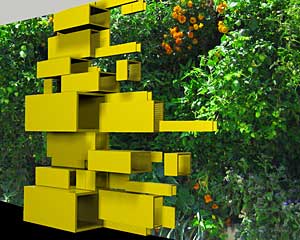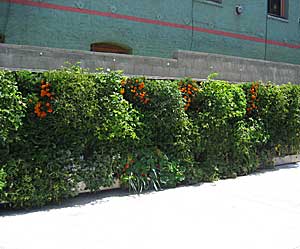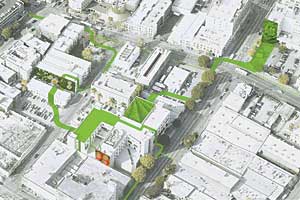Brilliant inventions usually result when someone asks the right question at the right time. Taja Sevelle, the founder and executive director of Urban Farming, a Detroit-based nonprofit dedicated to eradicating hunger, had just such a query for architect Robin Osler when the two met last year for the first time: If sedum and other non-edible plants thrive on green roofs and walls, why not tomatoes, peppers, and onions? If so, she reckoned, these gardens could supply free, healthy food for economically distressed neighborhoods.



Sevelle had consulted the right person. Osler’s Manhattan-based atelier, Elmslie Osler Architect, created a 2,000-square-foot green wall—the largest in the United States—for the Huntsville, Alabama, location of clothing retailer Anthropologie. After meeting Sevelle, Osler contacted George Irwin, whose firm Green Living Technologies manufactured the Anthropolgie wall system, and discovered that he was already experimenting with how to grow lettuce and other crops vertically. The team quickly came together and dubbed their project the Urban Farming Food Chain. It debuted this summer at four sites in Los Angeles’s Skid Row, a district that contains one of the nation’s largest homeless populations. The sites include a courtyard at the Michael Maltzan-designed Rainbow Apartments, a transitional housing facility for the homeless and mentally ill.
Each 30-foot-long-by-6-foot-high wall contains 4,000 plants growing in 180 square panels made of stainless steel; the panels, in turn, are divided into 4-inch-by-6-inch dirt-filled cells. Drip lines irrigate the crops from above and water drains through X-shaped slits on the underside of each cell. A fully loaded wall weighs roughly 15 pounds per square foot and can attach to an adjacent building or a freestanding metal framework.
“Bees and butterflies arrived within seconds after we put the walls up,” says Joyce Lewis, Urban Farming’s L.A. project manager, who organizes local volunteers to tend the vertical gardens. “They greened an environment that would otherwise just be concrete and steel.”
Lewis is still raising money to complete the first L.A. sites, but she’s already eyeing new locations across the city. Osler and Sevelle likewise hope to take the project to Chicago or New York, forming a nationwide “chain” of green walls akin to Frederick Law Olmsted’s Emerald Necklace park system.
“There’s been a definite shift across the country in understanding the value of locally grown food, but as a society we’re not very good about giving up valuable urban real estate for parks,” Osler explains. “The advantage of vertical farming is that it doesn’t take up a lot of space.”
Irwin adds that the green walls are about “more than just crops.” Projects like this can help create a sense of community among disadvantaged residents. “Sitting down to dinner,” he says, “always seems to bring people together.”



Post a comment to this article
Report Abusive Comment